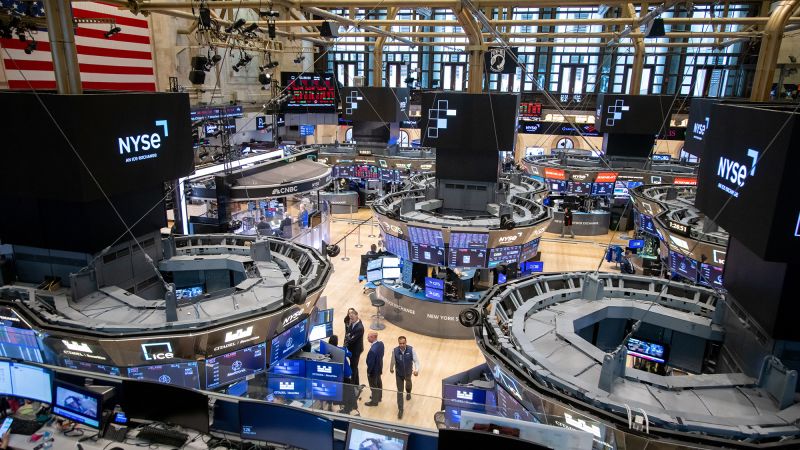The United States stock market is currently experiencing significant volatility, emerging as one of the most challenging periods in the context of a presidential term. With 2023 now underway, the market is on pace to record its worst first 100 days of any presidential administration since 1974, marking a stark contrast to expectations set post-Donald Trump’s reelection. Shortly after his reelection in November, Wall Street initially rallied, fueled by optimism for a pro-business environment. However, nearly 100 days into Trump’s second term, the reality of trade tariffs has injected a heightened degree of uncertainty and turmoil into the markets.
In tangible terms, the S&P 500, an index that reflects the performance of 500 of the largest companies in the US, has plummeted by more than 7.8%, erasing approximately $3.93 trillion in market value since Trump was officially inaugurated on January 20. As for the Dow Jones Industrial Average, the fluctuations have been equally marked; while it showed a slight increase of 40 points on a Tuesday morning, the broader S&P 500 fell by 0.3%, and the tech-heavy Nasdaq Composite Index decreased by 0.4%. Analysts are voicing concerns, speculating that the continued unpredictability surrounding US trade policy may indicate that the challenging conditions could worsen before they improve. Jonas Goltermann, the deputy chief markets economist at Capital Economics, emphasized this idea in a recent note, arguing that the current climate hints at particularly tough times ahead.
Historically, the S&P 500 could potentially register the third worst performance in the first 100 days of any presidential term, falling behind only Presidents Richard Nixon and Gerald Ford. On Tuesday, market close indicated that if there were a rally of 1% or more, it could still reflect as only the fourth-worst performance, falling just behind George Bush’s initial term where the index dropped by 6.9%. This financial landscape, where key economic policies overshadow fundamental metrics, is causing volatility, according to Terry Sandven, chief equity strategist at US Bank Wealth Management Group. The market is caught in a cycle of uncertainty with fluctuations expected to persist as visibility on tariffs remains clouded.
The turbulence this year can be traced back to Trump’s evolving tariff policies, which have caused the stock market to experience erratic shifts. The S&P 500, which reached a record high in February, fell into correction by March as tariffs began to unfold. The index faced further decline in early April after Trump announced his “Liberation Day” tariffs, hitting its lowest point of the year on April 8. Although the market has regained some strength since then, the overall sentiment remains negative, with the S&P 500 still down 2.5% from its pre-tariff unveiling position.
As investors grapple with these uncertainties, market analysts have been vocal about the extent of anxiety surrounding corporate earnings. Kelly Bouchillon, a senior partner at Sound View Wealth Advisors, remarked that this level of uncertainty is unprecedented and largely a consequence of the current administration’s policies. The so-called “Magnificent Seven” tech stocks, which previously bolstered the market’s rise, have broadly declined this year, with notable names like Apple (AAPL), Nvidia (NVDA), and Tesla (TSLA) experiencing respective downturns of 16%, 19%, and 29%. Instead, sectors like gold and tobacco have thrived; for example, Newmont Corporation (NEM) is up 45% and Phillip Morris (PM) by 40%.
Conversely, the declines have not been confined to stock performance alone. US Treasuries, traditionally a haven during market instability, have also faced skepticism. Investors began selling off these safe-haven assets, raising concerns about their reliability as stable investments. With the 10-year Treasury note yield dropping to 4.22% after peaking in early April, this raises questions about the market dynamics and foreign investor confidence in US financial instruments.
The US dollar has not fared well either; falling 8.5% in the first quarter of 2023, it hit a three-year low against a basket of foreign currencies. This decline has spurred discussions among investors about reallocation from US assets. Meanwhile, global indices, including Germany’s DAX and Hong Kong’s Hang Seng, have seen positive returns, leading to a growing inclination towards overseas stocks amid US market downturns.
In summary, Trump’s trade policy has introduced an unprecedented level of volatility into the market. The CBOE Volatility Index (VIX), which gauges market anxiety, experienced spikes reminiscent of the COVID-19 pandemic and the 2008 recession. Overall, gold has emerged as a favorable asset this year, rewarding investors looking for safety amidst unrest, projected to enhance further amid ongoing fluctuations in both domestic and international markets. As observations and evaluations of the first 100 days conclude, the upcoming response from both the administration and the market is keenly anticipated



